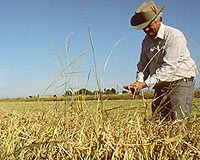 |
Washington DC (SPX) Sep 14, 2009 Agriculture, a large user of water for irrigation, is under pressure to reduce water use. Increased urban population growth has created more competition for limited water supplies. While growers have used soil moisture probes to aid in irrigation management in the past, earlier probes required maintenance or were expensive or inadequate. New electronic sensors have been developed that require minimal maintenance and are more affordable. This study evaluated and developed calibration information for one of the newer probes. These probes can be placed at different depths in the soil and show growers how deep water has moved. With probes such as these, growers can maintain water in the root zone better, and reduce over-irrigation. Minimizing over-irrigation reduces water loss and leaching of nutrients and promotes greater water use efficiency. Drs. Larry Parsons and Wije Bandaranayake of the University of Florida / IFAS Citrus Research and Education Center in Lake Alfred, FL carried out research on one of these new soil moisture sensors, the ECH2O EC-5 manufactured by Decagon Devices. Their study evaluated the sensors in terms of volumetric soil water content estimation, probe-to-probe signal variability, response to fertilizer-induced salinity, soil volume sampled by the probes, sensitivity to pockets of air or dry soil, response to compaction (bulk density changes), and response to changes in soil temperature. The results were published in the July-August 2009 issue of the Soil Science Society of America Journal and were presented at the annual meetings of the Soil Science Society of America held in November 2007 in New Orleans, LA. The work was funded in part by the Southwest Florida Water Management District. Results showed that the new sensor has several advantages. The ECH2O EC-5 was not sensitive to salinity or temperature fluctuations. Although the soil volume sampled by the probe was small (about 15 cm3), the probe responded well to changes in soil water content in the field. The change in probe response was negligible when soil pores (diameter 0.95 cm) were created near the probe surface. Probes were sensitive to changes in bulk density. Signal output increased when soil was compacted. Probe-to-probe output signal variation and response to differences in bulk density can affect the estimation of field water content unless necessary correction factors are utilized. Soil probes can be useful for monitoring soil water movement, estimating soil water content, and scheduling irrigation. They can be used on a variety of soils and with numerous crops. With a datalogger, soil water content can be monitored continuously over time and changing trends can be noted. Soil water data from these probes can be transmitted by radio to computers at other locations. Research using these and other sensors is continuing at the University of Florida to investigate ways to keep irrigation water in the main root zone, reduce deep percolation water losses, and minimize irrigation water use. With sensors such as these, improved irrigation efficiency is possible. Share This Article With Planet Earth
Related Links Soil Science Society of America (SSSA) Farming Today - Suppliers and Technology
 Nitrogen Soil Test Is Technology Breakthrough For Agriculture, Environment
Nitrogen Soil Test Is Technology Breakthrough For Agriculture, EnvironmentFayetteville AK (SPX) Sep 14, 2009 A new soil test for nitrogen fertilization of rice may not sound like blockbuster technology, but it is, said Chuck Wilson, extension rice agronomist with the University of Arkansas Division of Agriculture. The new technology is the first and only site-specific test of mineralizable soil nitrogen as a basis for nitrogen fertilizer recommendations in any crop. It will help farmers apply ... read more |
|
| The content herein, unless otherwise known to be public domain, are Copyright 1995-2009 - SpaceDaily. AFP and UPI Wire Stories are copyright Agence France-Presse and United Press International. ESA Portal Reports are copyright European Space Agency. All NASA sourced material is public domain. Additional copyrights may apply in whole or part to other bona fide parties. Advertising does not imply endorsement,agreement or approval of any opinions, statements or information provided by SpaceDaily on any Web page published or hosted by SpaceDaily. Privacy Statement |